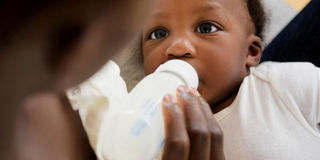Prime
Kenya announces ban on feeding bottles

Posed by a model: Kenya's Ministry of Health has announced a nationwide ban on feeding bottles from May 28. PHOTO | SHUTTERSTOCK
What you need to know:
- The teat also causes misalignment of the jaw because of the fact that a child has to bite on it, leading to dental carries because of sugars from the fluid in the bottle.
Kenya’s Ministry of Health has announced the ban on feeding bottles from May 28.
This comes after the Kenyan Parliament recently passed into law the Breast Milk Supplements (BMS) Regulation and Control Act of 2012 that listed the bottles used for feeding infants as designated products, to mean items that are within the scope of regulation by the law.
While addressing delegates at the country’s first ever National Maternal, Infant and Young Child Nutrition Symposium, organised by the ministry, Ms Esther Mogusu, the principal nutrition and dietetics officer at Nairobi Metropolitan Services (NMS), praised the government’s position and maintained that feeding bottles do more harm than good.
“The reason they are regulated is whatever content is fed (to a baby) using bottles is not breast milk, but often will be a non-nutritious fluid. The teats from which the child feeds on is made of silicon, which does not have the same texture as the breast nipple, and this causes what is known as nipple confusion, leading to refusal to breastfeed by the baby,” she told the Nation.
Ms Mogusu further explained that suckling from a bottle causes pressure to the inner ear and children will suffer recurrent ear inflammation.
The teat also causes misalignment of the jaw because of the fact that a child has to bite on it, leading to dental carries because of sugars from the fluid in the bottle. Bottles are not easy to clean because they have multiple grooves and often hide bacteria and microorganisms, making it difficult to clean through washing regularly, causing frequent diarrhoea and infections to the child.
According to experts, bottle use often interferes with breast feeding.
From May 28, bottles, teats, pacifiers and cups with spouts will not be allowed as containers for use in Kenya when it comes to feeding babies.
Manufacturers of baby foods, including infant formula, complimentary feeds and baby feeding equipment will be expected to comply with the standards and general regulations outlined in the law, the NMS principal highlighted.
Do not prohibit infant formula
According to Ministry of Health Nutrition Director Veronica Wanjiru Kirogo, the regulations do not prohibit infant formula, but only regulate its marketing.
“The Act gave the Health Cabinet secretary powers to make regulations touching on labelling, donations, information, education and communication, as well as interaction between BMS manufacturers and workers.”
“I totally agree with the ban, but it should come with guidelines because without training, information and alternatives, there will be no compliance,” Ms Martha Nyagaya, the Kenya country director at Nutrition International (NI) pointed out.
She further stressed that information on the importance of using a cup and spoon as an alternative to feeding bottles should be made available.
“Remember we have three per cent of children who are beneficiaries of alternative modes of feeding and are equally important. Banning bottles is just one step, we need to support women to implement it,” she said.
“We also need to recognise that the three per cent are vulnerable to malnutrition as they are not able to breastfeed, maybe because their mothers died at birth, among other reasons,” Ms Nyagaya said.
Social and Economic Effects
Dr Patrick Amoth, the acting director-general at the Health ministry, said as per the 2019 Social and Economic Effects of Child Undernutrition Kenya Country Report, in 2014, the Kenyan economy lost Sh373.9 billion (US$ 4.2 billion) or 6.9 percent of the gross domestic product due to health, education and productivity-related costs associated with child undernutrition.
The report also projected that reducing the prevalence of stunting from 26 percent in 2014 to 14.7 percent -- the target for Vision 2030 -- would yield cost decrease in economic losses due to child undernutrition of up to 40.7 percent.
This would result in annual average savings estimated at Sh33.2 billion and emphasise the urgency in addressing malnutrition.
Dr Amoth lamented that malnutrition was an impediment to the progress towards achieving the global, regional and national social and economic development goals, such as Vision 2030.
It was also the cause of half of child deaths worldwide, denying generations the chance to grow to their full physical and cognitive potential and significantly impacting health outcomes, and national economic development.
“In Kenya, malnutrition is a leading cause of infant and child morbidity, mortality and hospital admission, a situation that urgently requires our interventions as stakeholders,” said Dr Amoth, while officially opening the symposium.





